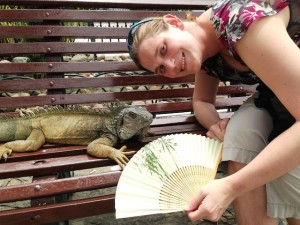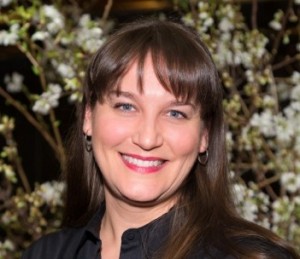JQ Magazine: From JET to the U.S. Department of State, Alumni Share Their Stories
By Sheila Burt (Toyama-ken, 2010-12) for JQ magazine. Sheila is a scientific writer at the Center for Bionic Medicine, a research group located within the Rehabilitation Institute of Chicago. She blogs about urban issues and Japan at www.sheilaburt.com, and writes the column “Letters from Japan” for Gapers Block. Follow her on Twitter @smburt.
Many of those who apply to the JET Program, and for several other teaching or translation positions in Japan, have a strong interest in international relations and diplomacy. But how does one transition from being eigo no sensei to a government career in the Foreign Service?
Via email, JQ reached out to three former ALTs who now work overseas for the U.S. Department of State to learn more about how they successfully made the big jump, and how their time in Japan influenced their respective careers.
Katrina Barnas, Consular Officer in Ecuador
Katrina Barnas (Chiba-ken, 2001-02) holds a BS in journalism from Northwestern University and a Master’s in Public Administration from Columbia University’s School of International and Public Affairs. After working for nine years in higher education administration at Columbia, she joined the Foreign Service in 2013 and recently started her first tour as a Consular Officer in Ecuador, where she assists American citizens in Ecuador and interviews other nationalities interested in traveling to the U.S. for tourism, study and work. She has also been an active member of the JETAA community, serving as vice president of the JET Alumni Association of New York (JETAANY) from 2005 to 2007, and then as a founding member of its board of directors from 2006 to 2011. Here, Barnas discusses how she applied to the JET Program on a whim—and how that decision ultimately shaped her future career path.
I wasn’t sure what I wanted to do after college. I had studied journalism but in my senior year, I was no longer sure that was the path I wanted to pursue. I liked traveling and children, so when some of my friends applied for JET I decided to apply as well. It is interesting to look back on it now since at the time I did not have a strong interest in Japan, but now I can’t imagine my life without a Japanese influence.
JET helped make my choice of joining the Foreign Service less daunting because I knew that I had done this before and succeeded. Through JET, I had experienced working in another country—getting beyond just a visit and belonging someplace very different from my hometown, and I knew that although it was going to be different that I could do it.
JQ Magazine: Book Review—‘Cinema of Actuality’

“Artists often make great sociological commentators, and Furuhata’s book sheds new light on the insights of these filmmakers.” (Duke University Press)
By Lyle Sylvander (Yokohama-shi, 2001-02) for JQ magazine. Lyle has completed a master’s program at the School of International and Public Affairs at Columbia University and has been writing for the JET Alumni Association of New York since 2004. He is also the goalkeeper for FC Japan, a New York City-based soccer team.
Yuriko Furuhata’s Cinema of Actuality: Japanese Avant-Garde Filmmaking in the Season of Image Politics examines a turbulent and disruptive period in Japanese history. As in other areas of the world, Japan in the late 1960s-early 1970s marked an era of youthful rebellion against the establishment, in both its public and private spheres. Furuhata’s analysis examines this period through the alternative Japanese film movements going on at the time, from New Wave figures like Masahiro Shinoda, Yasuzo Masumura and Hiroshi Teshigahara, to avant-garde filmmakers like Toshio Matsumoto and Kiyoteru Hanada. However, most of the films studied in the book are by Nagisa Oshima, largely considered to be the father of the Japanese New Wave and the “Jean-Luc Godard of Japan.” By eschewing the more traditional tendencies of the directors from Japan’s Golden Age such as Akira Kurosawa, Kenji Mizoguchi and Yasujiro Ozu, these directors incorporated such formalist experiments as jump cuts, disjointed angles, shaky handheld camerawork, pop music and, most importantly, the inclusion of television news footage.
Since many of these directors were relatively young, they shared the political sensitivities of the student protesters, who sanguinely staged media events to garner attention. The “season of politics” era was prominently displayed in nightly television newscasts, which covered a wide spectrum of politically disruptive events, from hijackings to hostage crises to mass student rallies and protests. The aesthetics of this new generation of film appropriated this contemporary media coverage in attempt to both reflect and critique it. By converging with other media cultures, these filmmakers engaged in a theory-filled dialog with the nature of representation itself, in effect becoming simultaneously media practitioners as well as theorists/critics. By making this powerful argument, Furuhata—an Assistant Professor of McGill University’s Department of East Asian Studies and World Cinema Program—forcefully disputes film scholar Noël Burch’s often-quoted notion that Japan was a cinema culture devoid of theory and serious study.
JQ Magazine: Book Review — ‘The Guest Cat’
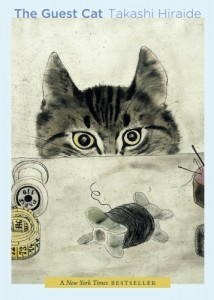
“This is one of many books that you simply cannot judge by its cover. At only 140 pages, The Guest Cat touches on a surprising range of interesting topics, and even if you’re not a cat person you can find a lot to like.” (New Directions)
By Julio Perez Jr. (Kyoto-shi, 2011-13) for JQ magazine. A bibliophile, writer, translator, and graduate from Columbia University, Julio is currently working at Ishikawa Prefecture’s New York office while seeking opportunities with publications in New York. Follow his enthusiasm for Japan, literature, and board gaming on his blog and Twitter @brittlejules.
Born in 1950, Takashi Hiraide is a talented writer across many fields including genre-bending essays and highly acclaimed poetry. His prose novel The Guest Cat (translated by Eric Selland) blends both together to produce a beautiful piece that was released in English last January. It is a winner of Japan’s Kiyama Shohei Literary Award and is a best-seller in France. This is one of many books that you simply cannot judge by its cover. At only 140 pages, it touches on a surprising range of interesting topics and even if you are not a cat person, you can find a lot to like in the book. Even the narrator admits that he does not consider himself a cat lover:
“There are a few cat lovers among my close friends, and I have to admit that there have been moments when that look of excessive sweet affection oozing from around their eyes has left me feeling absolutely disgusted. Having devoted themselves to cats body and soul, they seemed at times utterly indifferent to shame. When I think about it now, rather than my not being a cat lover, it may simply have been that I feel a disconnect with people who were cat lovers. But more than anything, I’d simply never experienced having one around.”
That is not to say that Chibi, the titular guest cat, is not lovable; on the contrary, she charms everyone she meets, but do not pass on this small gem of a book thinking it is simply a chronicle of an owner doting on his pet. It is better considered a story of how a special cat brings light and life into the minds of the humans that are blessed to have her company.
JQ Magazine: JQ&A with Melody Wong on the Drop That Eggroll Podcast

“JET gave me insight into a deeper rooted area of the Japanese culture that I appreciate. There were so many similarities of Japanese culture that I saw in my Chinese culture, and it really made me appreciate both as separate entities.” (Courtesy of Melody Wong)
By Wendy Ikemoto (Ehime-ken, 2006-2011) for JQ magazine. Wendy is a Hawaii-transplant and current Secretary of the JET Alumni Association of New York (JETAANY). When she isn’t working with librarians, you’ll find her visiting JET friends around the globe.
Melody Wong (Okayama-ken, 2011-13) is a native of Los Angeles and a member of the JET Alumni Association of Southern California (JETAASC). Prior to JET, she attended the University of California at Riverside and worked in finance for half a decade before deciding to switch things up to teach English in Japan. In December 2013, she launched the Drop That Eggroll podcast with her co-host and good friend, Alex Lau. Together, they explore subjects that span across Asian ethnicities, ranging from fun topics like pretty Korean boys and Filipino cuisine to more controversial fare like the Tiger Mother’s tips for success and ANA’s “whiteface” commercial.
Six months after DTE’s launch, JQ caught up with Melody to get the scoop on how the podcast came to be, what the future holds for it, how JET has influenced her views on the Asian culture, and why you all should be tuning in.
Can you start by describing your background for us?
I’m a second-generation Chinese American, born and raised in Los Angeles. I speak Cantonese and English fluently. The only Asian country I’ve ever lived in was Japan (two years), though I’ve traveled back and forth between China and the U.S. throughout my childhood.
Where were you on JET?
I was a JET in a tiny little town called Kibichuo-cho in the Okayama Prefecture. My town was so small and rural that even people in Okayama barely knew about it. There was no train station, so no one could really get to me unless they had a car, so I drove out everywhere all the time. I was an assistant language teacher (ALT) to multiple elementary and junior high schools.
How do you and Alex know each other?
Alex and I met through our mutual friend Larry. In high school, I was an avid member of the community service club, Key Club. My high school was part of a larger division that included lots of other local high schools, which is how I met Larry. Larry attended the Art Center College of Design and became friends with his classmate Alex. Through some social engagements, Alex and I met. All three of us, including several other friends, went on a trip to Japan in 2010, which was the trip that ultimately influenced me to join the JET Program.

“With wit and humor, Miyazaki offers insight from his long career with every turn of the page. Like an unforgettable sunset or the first time a cooking experiment came out well, he discusses experiences that leave you unexpectedly changed.” (VIZ Media)
By Alexis Agliano Sanborn (Shimane-ken, 2009-11) for JQ magazine. Alexis is a graduate of Harvard University’s Regional Studies—East Asia (RSEA) program, and currently works as an executive assistant at Asia Society in New York City.
I consider myself an aficionado of director and animator Hayao Miyazaki and Studio Ghibli. Having seen his work countless times, visited the museum in Tokyo and done a fair amount of supplemental reading, I figured Turning Point—a collection of Miyazaki interviews and articles spanning 1997 through 2008 and newly translated by Beth Cary and Frederik L. Schodt—would probably be a rehash of the similar. I presumed it would be a book for Japan or anime specialists. On the back cover there’s even a quote from the L.A. Times: “Essential reading for anyone interested in Japanese or Western animation.” However, this statement is entirely too narrow and ultimately misleading.
In fact, the book (which is a sequel to Starting Point: 1979-1996, also translated by Cary and Schodt and now available in paperback) is less about animation and Japan than it is the human condition and those existential questions that keep you awake at night. Miyazaki, at one moment reserved and the other candid, plunges fearlessly into complex, introspective and intellectual issues about human’s relationship with education, child-rearing, philosophy, history, art, environmentalism and war (to name a few).
He does this with a sprinkle of romanticism and a dusting with realism. Using his seemingly continual dissatisfaction with the world, Miyazaki aims to positively spark change and inspire. He insists that his films are not just flights of fancy; rather, he makes them to motivate the next generation to improve the world. “Children learn by experiencing…it is impossible to grow up without being hurt,” he writes. “Experiences like: accepting the duality of human nature, the importance of grit, conviction, and perseverance, and respecting nature and the land….For children willing to start, our films become powerful encouragement.”
JQ Magazine: Concert Review—Yoshiki Classical World Tour Dazzles San Francisco with Surprise X Japan Guest
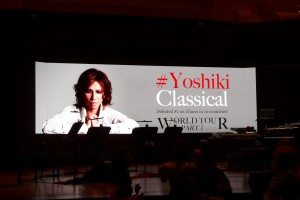
“The night offered something for everyone in Yoshiki’s ability to merge and bring together different genres and listeners and touch the collective beating heart therein.” (Shirong Gao)
By Shirong Gao (Shiga-ken, 2005-07) for JQ magazine. A member of JETAA Northern California, Shirong is a graphic designer, Illustrator, and breakfast food lover who worked in a Japanese countryside as seen only in Studio Ghibli movies. For more, visit gaoshirong.com.
Every night, as a child drifting off to sleep, I looped a rock ballad. My personal lullaby. A song by multi-million-selling heavy metal band X Japan, the Rising Sun’s answer to KISS. Yet not even in dreams did I see myself growing up to one day meet its leader, Yoshiki, and witness how far he’s come in his career.
A classically trained musician turned rock legend, Yoshiki has now returned to his more refined roots, embarking on a world tour of Yoshiki Classical concerts featuring music from the eponymous solo album released last year in collaboration with talents the likes of Beatles producer Sir George Martin and the London Philharmonic Orchestra.
On April 28, Davies Hall, home to the San Francisco Symphony, was packed on a Monday night to host only the second date of Yoshiki’s tour following its debut in Costa Mesa three days prior. “Definitely a different scene from a typical classical concert,” commented attendee Arisa Takahashi (Nara-ken CIR, 1991-92), who has also performed at the hall as part of the Sing Out, Davies! choral workshop. “There were people with blue hair, dressed in their frilly Lolita finery, sitting alongside classical music attendees.”
JQ Magazine: Book Review—‘Monkey Business Volume 4’

“In part, this collection is a quest. And it is a quest into questions, many of which straddle the thin lines of life, all the while hurling us through time and space, water and air, pain and pleasure, and beginnings and ends.” (A Public Space)
By Brett Rawson (Akita-ken, 2007-09) for JQ magazine. Brett is a writer, translator, and volunteer. He currently lives in New York, where he is pursuing an MFA in creative writing at The New School and is the professional development chair for the JET Alumni Association of New York. If you have job opportunities for JET alums, an interest in presenting at JETAANY’s annual Career Forum, or want to collaborate on professional endeavors, contact him at career@jetaany.org.
Meet Volume 4 of Monkey Business International: New Writings from Japan, a collection of 23 works that will take you on a wild ride through the literary landscape of Japan. In fact, it goes beyond the boundaries of Japan—as summed up by co-founders Motoyuki Shibata and Ted Goossen in the preface, Monkey Business International is “60 percent contemporary Japan, 20 percent contemporary American and British, and 20 percent modern classic Japan,” though of course not every hybrid has a categorical home.
In part, this collection is a quest. And it is a quest into questions, many of which straddle the thin lines of life, all the while hurling us through time and space, water and air, pain and pleasure, and beginnings and ends. Take for example the short story “The Man Who Turned into a Buoy” by Masatsugu Ono. The title itself seems to whisper, loosen your grip, encouraging us to suspend our disbelief and simply enjoy as our perspective gets gently nudged out of ordinary orbit.
The tale transports us to a tiny town nestled between the shoreline and the hills, which is overrun with frolicking monkeys who descend to steal food left on graves, but have been known at times to talk with villagers, and sometimes in the voice of the deceased. This town also observes the tradition of the body as a buoy—a single man tasked with the job of nakedly floating at the edge of the inlet during the day, issuing warnings to people who exit the bay. The man who turned into the buoy is the narrator’s grandfather, and his story is recounted through the grandmother in a dense dialect that is beautifully captured by translator Michael Emmerich.
JQ Magazine: Book Review — ‘Apparitions: Ghosts of Old Edo’
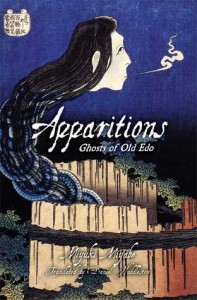
“Apparitions succeeds at not only giving historically accurate insight into the Edo period, but also delivers thought-provoking ghost stories that inspire fear and excitement with subtlety and expertly written dialogue and prose.” (Haikasoru)
By Julio Perez Jr. (Kyoto-shi, 2011-13) for JQ magazine. A bibliophile, writer, translator, and graduate from Columbia University, Julio is currently working at Ishikawa Prefecture’s New York office while seeking opportunities with publications in New York. Follow his enthusiasm for Japan, literature, and board gaming on his blog and Twitter @brittlejules.
Miyuki Miyabe is a Japanese author who writes widely popular fantasy, science fiction, and crime fiction for adults and young adults. Some of her works translated into English are Brave Story, ICO: Castle in the Mist, and The Book of Heroes. Published by Haikasoru last November, Apparitions: Ghosts of Old Edo is a collection of Miyabe’s short stories (translated by Daniel Huddleston) about pre-modern Japan depictions of ghosts, oni, and other supernatural events.
Apparitions includes nine short stories that are each unique but all so thoroughly engrossing that you can feel the immediacy of the narrator leaning in to deliver the chilling line foretelling the horrors yet to be revealed. Each of the stories captures the social hierarchy of the Edo period, which is a key element to illustrate in Japanese horror. One of the reoccurring aspects in Japanese ghost lore is an unbearably deep grudge that keeps a person’s spirit lingering after death. Edo society had a very rigid class system that is the source of frustration and resentment among characters, and this very resentment leads to vengeful ghost stories. This is why most ghosts in this genre are servants or women who are taking revenge on unjust masters, and insincere lovers of higher status. In this way, Japanese ghost stories are uniquely powerful in portraying the potential for wickedness in the human heart, whether it is the heart of the living or that of the vengeful dead. The supernatural dangers that appear in these stories all result from the cruel actions and thoughts of normal people that can and do occur every day. This is often exactly what is terrifying about these tales—not the ghosts, but the people.
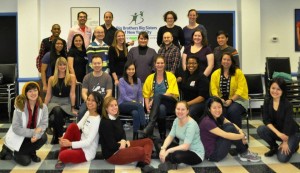
Members of the JET Alumni Association of New York volunteering in the annual Japan-a-Mania community event with Big Brothers Big Sisters of New York City, January 2014. (Courtesy of Monica Yuki)
By Eden Law (Fukushima-ken, 2010-11) for JQ magazine. Eden is JETAA New South Wales‘s webmaster, meaning he is the voice on all the online and social media for the Sydney-based chapter like Twitter, Instagram (both @jetaansw) and Facebook. Outside of JETAA, he doesn’t exist, and is merely a concept of a shadow of a dream of an enigma, wrapped in mystery and served with a side of salad.
Introduction
The following is a shamelessly biased opinion: Being a member of JETAA is fantastic. One gets to help organise and be involved in events and projects that reach the general public here in Sydney (like the Japan Festival), hang out with a great group of like-minded people that know all the best Japanese places to eat, drink and be merry, and who are rarely inhibited in any karaoke session. There is ample opportunity to new people constantly, both inside and outside that chapter’s home city’s J-community, so in a way, the JET experience never truly ends.
That’s a personal assessment of what it’s like being a member of JETAA, the alumni association for former JETs. JETAA chapters exist all over the world from where the JET Programme has drawn its recruits. They give former JETs a way to connect with their local J-community and like-minded peers, and are essentially a non-profit social organisation with a Japanese cultural bent. And because JET is made up of a diverse group of people from all walks of life, JETAA chapters have great potential as a resource with links in government, business, education, academia and social networks.
But it can’t be denied that many chapters struggle with visibility or relevancy, in attracting members to events or to join their committees. The last point is especially important, as new members help to keep the organisation dynamic and active. And while the reasons for this are different for every situation, some similar and salient points can be discerned, notably from online forum comments (like LinkedIn). While a comprehensive discussion can probably fill a volume or ten, this article will nevertheless discuss these points.
So what does JETAA have to deal with?
JQ Magazine: NY JET Alum Collaborates with Japanese Expats on ‘2nd Avenue’

JET alum Tony Waldman (second from left) on the set of Web series 2nd Avenue. (Courtesy of Tsukasa Kondo)
By Julio Perez Jr. (Kyoto-shi, 2011-13) for JQ magazine. A bibliophile, writer, translator, and graduate from Columbia University, Julio is currently working at Ishikawa Prefecture’s New York office while seeking opportunities with publications in New York. Follow his enthusiasm for Japan, literature, and board gaming on his blog and Twitter @brittlejules.
She’s an aspiring actress with visa problems; he’s a gay law student and newly homeless. Can a fake marriage solve their problems? Mariko and Taichi are the stars of a goofy Web comedy filmed on location in New York called 2nd Avenue. You can tune into their zany adventures on YouTube and view the entire six-episode first season, which ended this past February.
The creative team behind 2nd Avenue includes Mari Kawade (director), Maho Honda (who plays Mariko), and Tsukasa Kondo (who plays Taichi). Kondo, who also is the writer for the series, was inspired by the many Web series online and decided to try writing something that would never be seen on Japanese TV, but would have a place on YouTube. He adds that his biggest inspirations for the story are “the actress Maho Honda, my life in New York as a gay man, and American TV shows.” Honda and Kawade also cite the diversity of New York City itself, and the stories of what people do just to survive in it, as a significant creative inspiration.
As you may have guessed, you can’t do something awesome involving Japan in New York without some JET alumni getting involved. Tony Waldman (Mie-ken, 2005-09) and his group New Beard provide the soundtrack for the show. The idea for this pairing took root after he met Kawade at the JET Alumni Association of New York’s annual Meishi Exchange event in 2013.
“She mentioned that she was looking for music for this Web series,” Waldman says. “We exchanged contact info and kept in touch. Many months later, she…asked if we could use my band New Beard’s music in the show. Us here in Beard Town (Williamsburg) gave her the OK, and our music became the soundtrack to the entire show…a true JETAANY Meishi Exchange success story!”
JQ Magazine: From JET to Japan-Related Jobs – New York Edition
By Brett Rawson (Akita-ken, 2007-09) for JQ magazine. Brett is a writer, translator, and volunteer. He currently lives in New York, where he is pursuing an MFA in creative writing at The New School and is the professional development chair for the JET Alumni Association of New York. If you have job opportunities for JET alums, an interest in presenting at JETAANY’s annual Career Forum, or want to collaborate on professional endeavors, contact him at career@jetaany.org.
If you listen closely, the age-old JET adage every situation is different can be heard echoing around the world. This is because it’s said so frequently, but that’s because there is truth to the takeaway: Paths to JET, experiences in Japan, and adventures thereafter run in every direction. But when the stories sit side by side, a greater context for, character of and meaning to the program and participants, takes solid shape.
Below are features on three New York City-based JET alumnae. Each carved a unique path to, on, and from the program, but they share one incredible thing in common: they are working at three of the largest Japan-related non-profit organizations in the world. For those interested in following in their professional footsteps, JQ would like to introduce to you them and share their advice about entering the world of Japan-related non-profits.
Meet Christy Jones, Director of Special Events at Japan Society
ALT, Shimabara-shi, Nagasaki-ken, 1995-98
Born and raised in Upstate New York, Christy received a degree in cultural anthropology and a certificate in Asian and African Languages and Literature from Duke University. That was the closest she could get to a degree in Japanese, but it wasn’t the closest she got to Japan: Her junior year, she studied abroad at Kansai Gaidai University in Osaka. But that stint didn’t quite quench her thirst for the cuisine and culture. The following fall, she applied to JET, got accepted, and returned to Japan—but this time for three years.
Christy served as an ALT at an academic high school in Shimabara-shi in Nagasaki. Thinking back, she has very fond memories of her time on JET: “As this was the pre-Internet era, I didn’t know much about Nagasaki beyond the atomic bomb,” she says. “I came to appreciate the rich international history of the area, along with the stunning natural beauty. Some of my happiest moments were traveling around Kyushu, visiting fellow JETs in their own towns, checking out the local onsens, cafes, and izakayas, and taking thousands of photos. I was befriended by a number of local residents, which allowed me to have some uniquely Japanese experiences: delivering mail as an honorary ‘Postlady for a Day’; making yakimono in a backyard pottery studio and kiln; watching a bonfire-lit Noh performance at the base of a castle; and marching in the city’s annual parade dressed like a Portuguese missionary.”
When Christy returned home, she let her experience settle. “Eventually,” she recalls, “I visited NYC to attend JETAANY’s annual Career Forum, which happened to be held at Japan Society that year.” She connected with a couple of headhunters and landed a job working as an administrative assistant for a subsidiary of Sumitomo Chemical for two years, but the work itself didn’t fulfill her: “My workday ended at 5:30 sharp, so I started volunteering at the nearby Japan Society events as an usher and ticket-taker,” which is when everything began to change.
JQ Magazine: Book Review – ‘Cool Japan: A Guide to Tokyo, Kyoto, Tohoku and Japanese Culture Past and Present’
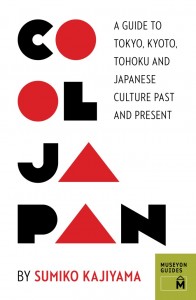
“Cool Japan focuses on giving an inside look into the enduring and captivating qualities of Japan’s culture and history and how it can be discovered by visiting Kyoto, Tokyo, and the Tohoku region.” (Museyon Guides)
By Julio Perez Jr. (Kyoto-shi, 2011-13) for JQ magazine. A bibliophile, writer, translator, and graduate from Columbia University, Julio is currently working at Ishikawa Prefecture’s New York office while seeking opportunities with publications in New York. Follow his enthusiasm for Japan, literature, and board gaming on his blog http://brittlejules.wordpress.com and Twitter @brittlejules.
When was the last time you picked up a non-fiction book and felt like you were escaping to a faraway land? Cool Japan (Museyon Guides) is the special kind of guidebook that does just that.
The author, Sumiko Kajiyama, is a journalist and scriptwriter residing in Japan. Her other books include Ghibli Magic, The Man who Changed Animation Business, The Way of Work by Top Producers, and Important Things to Enjoy Your Work and Life.
In any bookstore you will find Frommer’s, Lonely Planet, and Fodor’s travel guidebooks. You may own a few already from trips you have taken in the past. While these guides are meticulously researched and written to suit a traveler’s needs, there is an inherent problem that they all have in common: over a relatively short amount of time, prices for services or goods can change, hostels can move or go out of business, and new ones can pop up in yet undiscovered places. For these reasons, and many that need not be mentioned, the Internet has become an invaluable tool for anyone planning a trip. Many digital communities of travelers have evolved for the exchange of current information. Furthermore, smartphones allow today’s travelers to access all of this information on the go.
So you may be wondering, why buy a guidebook at all? There are many reasons to buy the ones listed above, despite the weakness of having an ever-decaying reliability of information. Cool Japan is a special because it does not squander space listing information that may no longer be relevant by the time it gets into your hands, but instead Cool Japan focuses on giving an inside look into the enduring and captivating qualities of Japan’s culture and history and how it can be discovered by visiting Kyoto, Tokyo, and the Tohoku region.
JQ Magazine: JQ&A with Jim Breen of Monash University on WWWJDIC

“I just spent several weeks in Finland and Sweden, where the level of English speaking is extremely good. No JET Programmes there. You can’t even argue that they are related languages—Finnish is just as foreign as Japanese, and probably has fewer gairaigo (borrowed words). How do they do it? By teaching it properly in the first place, with trained and qualified teachers.” (Courtesy of Jim Breen)
By Tim Martin (Fukui-ken, 2006-08) for JQ magazine. Tim is a neuroscience researcher and swing dancer based in New York City. He runs a blog called The Floating Lantern, where he writes about humanism and other things that matter. Lately he is trying to learn more about effective altruism and the science of applied rationality.
Jim Breen is the man behind a resource that probably every English speaker trying to learn Japanese has used: the massive WWWJDIC online dictionary. In the 1980s, Breen developed an interest in Japanese that led to him programming a Japanese dictionary for DOS as a hobby. While a professor of digital and data communications at Monash University in Melbourne, Australia, Breen continued working on the dictionary, until eventually it bloomed into an interface that connects and cross-references hundreds of thousands of entries for words, names, and kanji.
Now a recognized authority on lexicography and the Japanese language, Breen continues to work on his “hobby,” and is pursuing a Ph.D. in computational linguistics. In this exclusive interview, JQ spoke with Breen to find out how it all began, his thoughts on language teaching and the JET Programme, and how he thinks technology will affect our experiences with foreign language in the future.
How did you develop your interest in, as you say on your website, “things Japanese”? Is there a specific part of Japanese culture or media that got you hooked?
I guess my interest in Japan over other foreign countries began around 1977 when my eldest daughter, then six years old, began to study the violin using the Suzuki Method. My wife, a musician and music teacher, had heard about the Suzuki Method from a lecture and demonstration, had been extremely impressed, and had expressed an interest in our children studying in the method. From that point on Suzuki began to play an increasingly bigger part of our lives as our second and third children began to study within that method. Also, my wife began to explore teaching in the Suzuki Flute Method.
None of this interest was particularly focussed on Japan itself. In 1980, I took most of the year off work to complete my MBA (I was a budding junior executive in Telecom Australia in those days). A fellow student in our classes had studied Japanese, and impressed me by translating some of the titles of pieces in the Suzuki books. Also among the visiting lecturers was a former trade commissioner in Japan, who spoke eloquently about the importance of Japan and the need for people trained in Japanese. I recall going home that night and saying to my wife: “I think I’d like to study Japanese eventually.” She didn’t think much of the idea, and I concentrated on other things like finishing my MBA and completing a music performance diploma.
In mid-1981, my wife said one day that she thought she really should go to Japan to study teaching Suzuki flute with Toshio Takahashi at the Suzuki headquarters in Matsumoto, as there was no one in Australia teaching Suzuki flute. I liked the idea, and we agreed to go the following December and January, which is Australia’s summer period when schools are closed. Our kids, then aged ten, seven and three, could easily miss a couple of weeks school in December. I arranged two months’ Long Service Leave from Telecom (LSL is a employee right in Australia after you have worked more than 10 years with an employer), and after struggling for a short while with Teach Yourself Japanese (all Kunrei-shiki romaji), I also arranged to have weekly Japanese lessons with Brian Drover, who trained as a Japanese linguist in the Australian army during WWII.
So, in late November 1981, five Breens arrived at Narita, made our way into Tokyo, were popped on a Chuo-sen train to Matsumoto by people from the Suzuki organization, and later that day found ourselves being greeted by a welcoming party from the Nagano Girl Scouts(!). (My eldest daughter was a Brownie, so we had set the international tom-toms working.)
We spent two months in Matsumoto living in two tiny six-mat apartments rented to us by the mother of some local Girl Scouts. My wife had piano and flute pedagogy classes, my kids had lessons in violin and piano (the former with Shinichi Suzuki himself), and I did the housework, shopped, minded kids, tried to study Japanese, etc.
I guess I don’t have any particular parts of Japanese “culture” I concentrate on—my tastes are rather catholic in this regard.
JQ Magazine: Staying On—JETs in Fukushima Share Their Stories
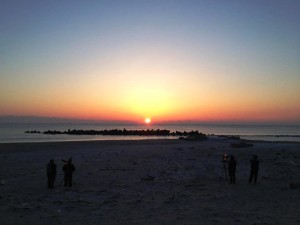
Sunrise over Iwaki: A local pre-dawn commemorative service took place on March 8, 2014, which included taiko performances and ended with the sunrise over the beach near Shinmaikohama Park. (Alexandrea “Xan” Wetherall)
By Eden Law (Fukushima-ken, 2010-11) for JQ magazine. Eden lived and worked in the core city of Iwaki on JET, and he is a current committee member of JETAA NSW, based in Sydney, Australia.
Introduction
It’s been three years since the Great East Japan Earthquake of 2011. While the rest of the world, and arguably, the rest of Japan, has moved on, communities all along the east and north coast continue to endure and deal with the continuing legacy and consequences of that event, especially those displaced from the exclusion zone around TEPCO’s Daiichi plant.
The JET Programme continues to operate, with the government previously announcing plans to double the number of participants over three years. JETs continue to live and work in Tohoku, including JETs who were there before the earthquake, joined later by those placed after 2011. This article will examine the experiences and viewpoints of JETs who continue to work and live in Tohoku, in particular, those living in Iwaki, Fukushima, a city just past the the southern edge of the nuclear exclusion zone. Three years on, they will relate what they’ve seen and observed in their neighbourhood and the city. In addition, the viewpoints of two local Japanese residents will also be included, one from a retired member of a suburb in which evacuees have been housed; and a Japanese English teacher and mother of two.
Before the earthquake, Iwaki was one of the biggest rural cities in Fukushima, with a thriving fishing and farming industry, popular with tourists who come for its natural beauty and well-known beaches. A region rich in history from the Nara period (and prehistory, with its own dinosaur and fossil museums), it also has a famous theme park called the Spa Resort Hawaiians (made famous by the 2006 award-winning film Hula Girls) as well as the Aquamarine Fukushima aquarium. A mere 2.5 hours away from Tokyo by express train, it also supports a large JET community, ideal for those wanting to experience a rural pace with easy access to the bright lights of Tokyo. As a JET placement, it was arguably one of the best places to be.
JQ Magazine: JQ&A with Cade Mosley on His Return to Japan with Rotary International
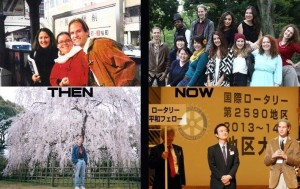
“In my experience, Japan is going through an interesting evolution these days. It’s starting to take a more assertive role in international affairs and taking more of a stand for human rights, development, and peaceful relations. This also makes it a very interesting time for Westerners to be engaged in Japan more than ever before.” (Courtesy of Cade Mosley)
By Mark Flanigan (Nagasaki-ken, 2000-04) for JQ magazine. Mark is a program director at the Japan ICU Foundation in New York City and was also a Rotary Peace Fellow at ICU from 2010-12, during which time he volunteered for a tsunami relief mission in Ishinomaki after the terrible 3/11 tragedy. In addition to his JET and Rotary service, Mark has also been a U.S. Army officer, Presidential Management Fellow, Pacific Forum CSIS Young Leader, Eisaku Sato Memorial Essay Contest prize winner, and Aspen Institute Socrates Program Seminar scholar. His interests lie in international education, disaster response, and post-conflict peacebuilding. He can be contacted at mflanigan[at]jicuf.org.
Christopher Cade Mosley (Nagasaki-ken, 2000-01) is a current Rotary Peace Fellow at International Christian University (ICU) in Tokyo and previously served as a JET for one year. Born in Texas and raised mostly in Fort Worth, Mosley attended the University of Texas at Austin, majoring in government and philosophy. He also spent a semester abroad in Haifa, Israel and interned for Congressional House Majority Leader Dick Armey in Washington, D.C. He was also on student government for their department (Liberal Arts), chairing the committee on study abroad. In this exclusive interview, JQ caught up with Mosley to discuss his lifelong interest in politics and international affairs.
Thanks for your time and for answering our questions, Cade! Would you please tell everyone about your time on JET?
I was a JET in 2000-01 on a long, thin island called Tsushima in Nagasaki, but physically closer to the city of Fukuoka, nestled in the strait between the cities of Pusan and Fukuoka. Tsushima is famous for a decisive sea battle Japan won against Russia in 1905 that first put Japan on the map as a world power and set its course into the 20th century. There’s a massive Russian battleship sunk just off the coast from my apartment there! (Too deep to see, though.) I taught for the second largest district, called Mitsushima, on the south end of the island.
What was your JET role?
I was an ALT at four schools in my district, spending a week in each so that I would rotate through all four in a month. I spent Monday through Thursday assisting the teacher with the lesson, usually coming up with some creative activity or role play to complement the lesson, and Fridays at our BOE.
Did you have any previous background in Asian languages and cultures?
I actually was accepted to JET while I was teaching English in Seoul, South Korea, and my friends there insisted I take the opportunity. Before Seoul, I didn’t have any experience. My whole reason for going to Seoul and applying to JET were because I had zero experience with Asia and thought it would be a good chance to get to know the region, since I was already interested in international affairs at that time.

